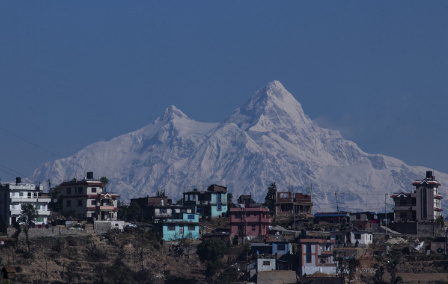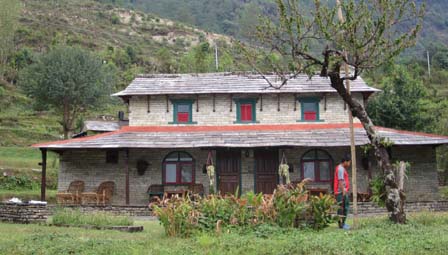
Published 28th Jan. 2025
Reading time
Nepal is no stranger to tradition. From Himalayan hikes and lively festivals to mountain monasteries and deep-rooted religion, the country has a lot to celebrate. However, there’s another aspect of daily life deserving of fanfare: its cuisine. Traditional food in Nepal is as tasty as it is nourishing, reflecting the country’s timeless traditions and cultural influences. Whether savouring sekuwa on busy streets or sharing momos at an authentic restaurant, read on for our pick of Nepal’s nicest nibbles. Stomach rumbles starting in three, two, one...
Life’s greatest pleasures are often the simplest, and dal bhat is no exception. This humble plate of rice (bhat), lentil soup (dal), pickled vegetables and crisp flatbread packs a surprisingly delicious punch, thanks to spices like turmeric, ginger, cumin and coriander. It’s so nice it’s eaten twice, with Nepali people typically enjoying the protein-rich dish morning and night – and for good reason. Full of fibre, low in fats and loaded with healthy carbohydrates, it’s thought to sustain energy levels while hiking at high altitudes. There’s even a rhyme to match: Dal bhat power, 24 hour! Catchy.
The best traditional food in Nepal can be found in all corners of the country, from big-time restaurants to small-time street vendors. Introducing momos, Nepal’s delicious dumplings. Consisting of a simple dough stuffed with minced meat (chicken, pork or lamb) or vegetables (spinach, cabbage or potato), momos are seriously moreish. Flavour comes in the form of garlic, onions and paneer on the inside, and tangy chutneys for dipping on the outside. Credit where credit’s due – momos can be traced back to Tibet and were introduced to Nepal by settlers in the Kathmandu Valley.
Chatamari, or Nepali pizza, is a Nepalese take on the Western classic. However, the snack’s round shape is where the similarity ends. The typical bready base is swapped for a rice flour crepe hailing from the Newar people, and tomato is forgotten in favour of minced buffalo, onion, chillies and egg. This crispy crepe is a winner among vegetarians, meat lovers and anyone in between, as toppings can be chopped and changed as pleased.
Vegetarians and vegans, you might want to skip this next traditional food in Nepal. The seriously succulent sekuwa entails marinating tender chunks of lamb, chicken, pork or goat in Himalayan herbs and spices. They’re then skewered and grilled over hot coals until soft and smoky before being devoured in one. Sekuwa has strayed from its centuries-old finger-food origins with restaurants often serving it alongside rice, salad and chutneys.

Step aside savoury dishes – it's time for sweet Nepalese cuisine to take centre stage. On the surface, yomari may seem unassuming... but there’s more to the simple steamed dumpling than meets the eye. Shaped like a fish or fig, the rice flour-based dough contains chaku, a mix of sugar and ghee. Beyond its tasty reputation, yomari carries cultural significance at the Yomari Punhi festival, celebrated during December’s full moon. The festival marks the end of the rice harvest, and yomari is offered to the gods as a symbol of gratitude. A deliciously divine gift, if you ask us.
Another festive favourite in Nepal is sel roti, a sweet ring-shaped snack served during the popular Hindu festivals of Dashain and Tihar. To make the dough, rice flour, sugar and butter are thrown together, flavoured with spices like cardamon and cloves, shaped into a ring and then deep fried. Crunchy on the outside and oh-so-soft on the inside, sel roti is also served at weddings as a symbol of unity and good fortune. These golden goodies even have a shelf life of 20 days – although we’d be surprised if they haven’t been gobbled up long before.

Written by Evie Buller. Header Image by Daria Nikitina.

Travelling with us means enjoying a trip that has been meticulously crafted by our team of experts, each knowing their specialised country like the back of their hand. Tailor-made with originality, quality and cultural immersion in mind, we can customise itineraries based on your taste, be that an architecture aficionado, a food fanatic or an environment enthusiast. Working hand-in-hand with local Concierges and guides, we’ll uncover spots perfect for you. From hidden gems to iconic landmarks, our curated experiences are supported by an array of additional services, including a 24-hour helpline and an app full of recommendations.
ENQUIRE NOWPractical advice and inspiration for your next trip

Nepal is home to an impressive eight out of the world’s ten tallest mountains, so it’s no surprise that the hiking is legendary. The Himalayas are a rambler’s dream, with thriving forests, glistening glaciers, perilous mountain passes and thrilling panoramas. But trekking in Nepal isn’t for the fainthearted. High altitudes, steep ascents, changeable weather, and tricky terrain are all part of the challenge (and fun).
18th December 2024 - Nepal Adventure

Gurung Lodge Gurung Lodge is located on the edge of the village of Majgaun, and views of the surrounding valley and mountains, especially Annapurna South and Annapurna One, are spectacular. Built in the style of a traditional Nepalese village, the lodge has ten large ensuite rooms all housed in tribal style cottages with antique carved windows. The cottages are dotted around the grounds, therefore the whole lodge feels spacious, and each cottage has a couple of sun loungers outside.
28th June 2021 - Nepal Hotels

When it comes to romance, Greece’s islands set the bar high. From Paros’ sun-kissed beaches and Folegandros’ blush-pink blooms to Sifnos’ culinary delights and Hydra’s slow-paced streets, each island radiates beauty. Whether you fall in love with the sunset in Santorini or the atmosphere in Apollonia, the perfect spot awaits. Read on to discover the most romantic islands in Greece... Paros Folegandros Sifnos Hydra Santorini Paros Best for:
27th October 2025 - Greece Travel Inspiration

Our team of destination experts will get to know you and your unique requirements for your holiday

We work with you to build an ultra-personalised holiday itinerary with your choice of accommodation, experiences and activities

All of our holidays include little extras designed to make a big difference to your trip, from fast-tracking you through airport check-in and security to our network of local Concierges